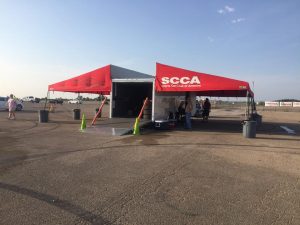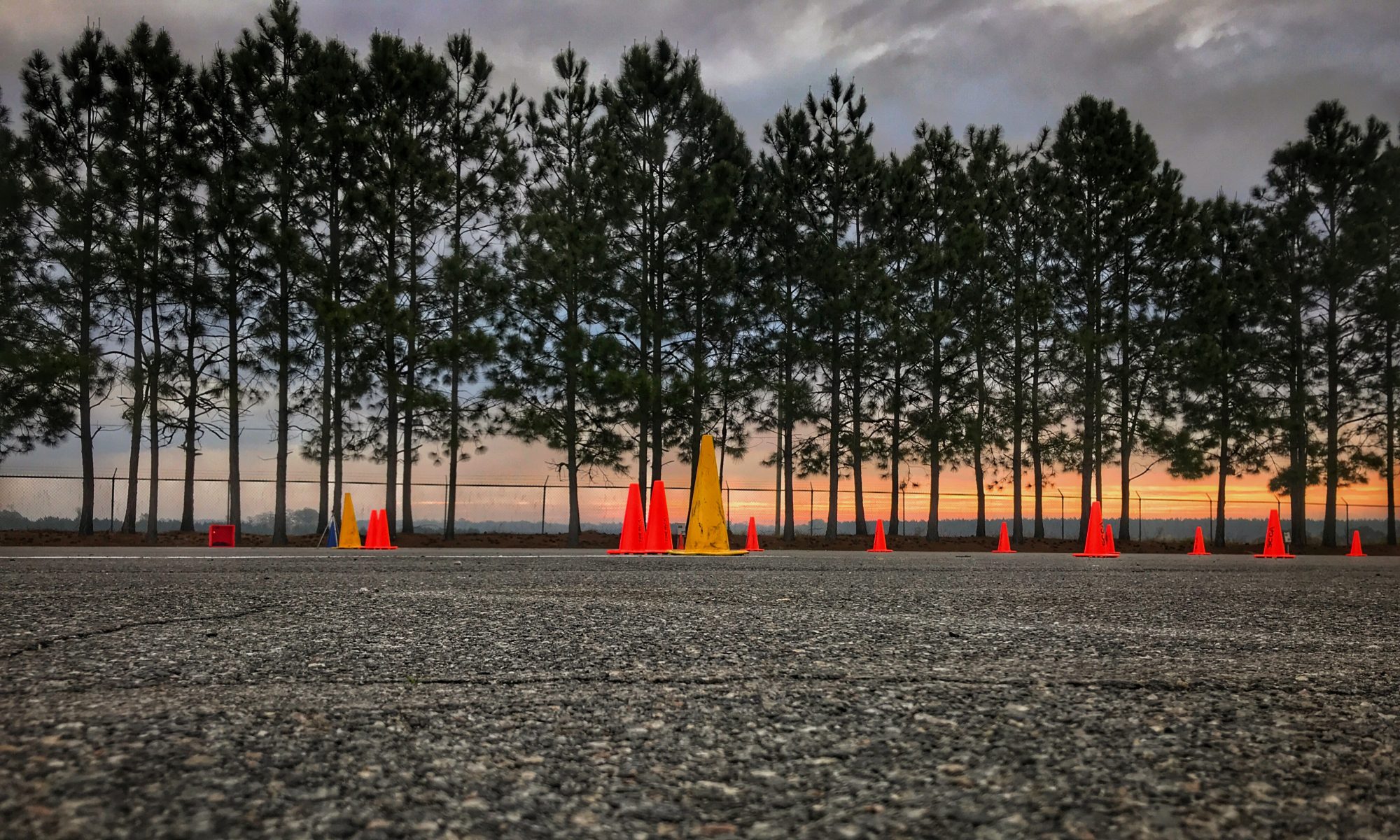Based on a post by Steven Duckworth:
FRIDAY (OR DAY 0)
Arrive at site, sign the waiver, get your wristband, continue to paddock, and start prepping your car for tech.

Tech is a bit more strict than at local events. Be sure to have legal and easily visible numbers and class letters. Tape is not going to cut it unless you are a true artist.
National Tours require event decals and contingency stickers (if you have signed up for contingency). All required decals are available at tech along with some of the contingency decals, depending on the contingency provider. Hoosier/TRD/Mazda stickers are not available on-site. Go grab them, apply them to your car, and take it to tech. At minimum, it’s one Tour or ProSolo sticker per side, one SCCA sticker on the front of the car, and the Tire Rack banner across the windshield (any other windshield decals will need to be covered). If you don’t want to stick decals directly on your paint, use some painters tape on the paint, then stick the decals on that. For other decal placement, refer to the specific contingency document (https://www.scca.com/pages/solo-contingency).
Once you’re at tech, if you’re in a class where you need to be weighed (P, M, SM, CAM), you will need to tell the tech inspector your minimum weight for class (know this beforehand) and it will be written on your tech sticker, and preferably your car’s wheelbase as well (This is so they can set the scales the proper distance apart when you pull up to weigh). Also let them know if you are a 2 driver car and get the 2 decal for the windshield too. Be sure to bring your helmet to tech too, as you’ll need a tech sticker on it (The sticker is good for the entire solo season). And if you’re co-driving and don’t even have a car to tech, make sure you swing by with your helmet to get it checked and stickered.
Next you hit registration (usually in the timing trailer), make sure to have your SCCA card ready. Hand it to the person at the window and they’ll ask you to confirm your class, number, and tires (for contingency). Be sure to get a barcode when they offer it, then stick it either on the left side of your helmet (preferably) or on the windshield/roof where it’s accessible to the person scanning them near start. If you are sharing a helmet, be sure to cover any barcodes that do not belong to the driver before his/her run, scanning the wrong barcode can result in that run being tossed out.
Once that’s done, Test & Tune is typically available if you’re on-site in time.
SATURDAY (OR DAY 1)
Tech and Registration are still available for anyone who arrived too late on Friday, but there are no changes allowed to your registration
On event morning, things start earlier than locals. First car out Saturday is a 9am start. DO NOT lollygag at the hotel. Get on site, get some course walks done, and be ready for the day’s activities. The next big difference from locals is the assignment of grid spots. At the trailer/tent where Tech took place, you’ll find the driver information center. Grid sheets will be posted there, and you can find what spot your car needs to go in. This can change overnight, so be sure to check both mornings. There will be an A and B grid for the even and odd run groups, so make sure you’re in the right one when you bring your car up. Worker check in will also be at that tent when it’s time.
Champ Tours and Match Tours will have a drivers meeting on Saturday. ProSolo will not.
Once it’s your run group, make sure you’re at your car when the grid person gets to you. You will have someone going around giving a 5 car warning that will try to yell and find you if you’re not near your car, but please don’t make them have to do that. If you’re not ready when the grid “sender” gets to you, you’re probably going to get skipped. On your first run, you’ll need to stop for someone doing Car Checks to take pictures of the front, side, and rear of your car (again for contingency purposes), do not run this person over. Then stop at the scanner and let them scan your barcode. Follow the line up at the starter like you’re used to.
When you return from a run, the car has a minimum 5 minutes before it can be sent again. This usually only comes into play for 2 driver cars toward the back of grid, or in the event of a re-run. If a re-run is called on you, a grid person will put you on a clock, and you will be sent when that 5 minutes is up. If you’re in a situation where you feel like you’re being rushed and not getting your 5 minutes between runs to cool the car because of other circumstances (like a 2 driver car at the back of grid), let a grid worker know and ask if they can start a clock for you. You are also entitled to 10 minutes for mechanical issues should you need to fix something on your car before it can run, and you do this by telling the “sender” that you want to call a mechanical when they get to you. They’ll put you on the clock and move on.
After your 3rd run, if you are a weighed class, go to the scales to get weighed. If you’re a “weigh without driver” class, it only needs to go after the 2nd driver. Make sure you know your car’s wheelbase so the scales can be adjusted for you. Jump out, they’ll push it on the scales, you’ll have to jump back in if you’re a “weigh with driver” class, then push it off, fire it up, and drive it back to grid. EVERYONE has to go back to grid after their 3rd run for impound and pop your hood and trunk (at a ProSolo you will be directed to a separate impound location). You’ll be held there until the provisional results can be printed and brought to you, and once everyone is in agreement that they look right, you’ll be released. DO NOT leave impound until you are released, and don’t leave grid during the run group either. In some rare circumstances, you will be asked to do something like lift one side of the car or remove a wheel, so it never hurts to take a jack and jack stands to grid with you. It’s not as common at National Tours as it is at Nationals, but better safe than sorry. If you think you’ll need different tires for inclement weather (we don’t say “that word” before events), make sure to bring them to grid too.
Working course at a champ tour is different than a normal local event. At each corner in addition to cone shaggers, there will be one worker holding the radio and flag plus a second worker holding a clipboard to record the cones and DNFs . Usually at tours, cones are marked with a number. When a cone call is made, the logger will record the number of cones hit and which cone numbers they were. After approximately half the cars have gone for that run, a sweep car will pick up those sheets and take them to the info tent where drivers can refer to them if they have a question about which cone got hit. The sweep car will come around 6 times. Match tours do not use audit sheets.
And most importantly, once the runs are done, don’t pack up and head back to your hotel. Stick around, meet new people, hang out with your competitors, and enjoy the social aspect of the sport. Make sure you get some course walks in while it’s still daylight for the upcoming day, because it’s gonna be an EARLY start!
SUNDAY (OR DAY 2)
The second day of the event will run exactly like the first with a few exceptions. There is no registration, tech or drivers meeting. The means day 2 can start an hour earlier. So make sure you set your alarm.
Once competition is over hang around and watch the trophy presentation (whether you won or one of your friends did). Then spend the drive home planning your second National event.
Remember, if you have any questions, just ask someone.
